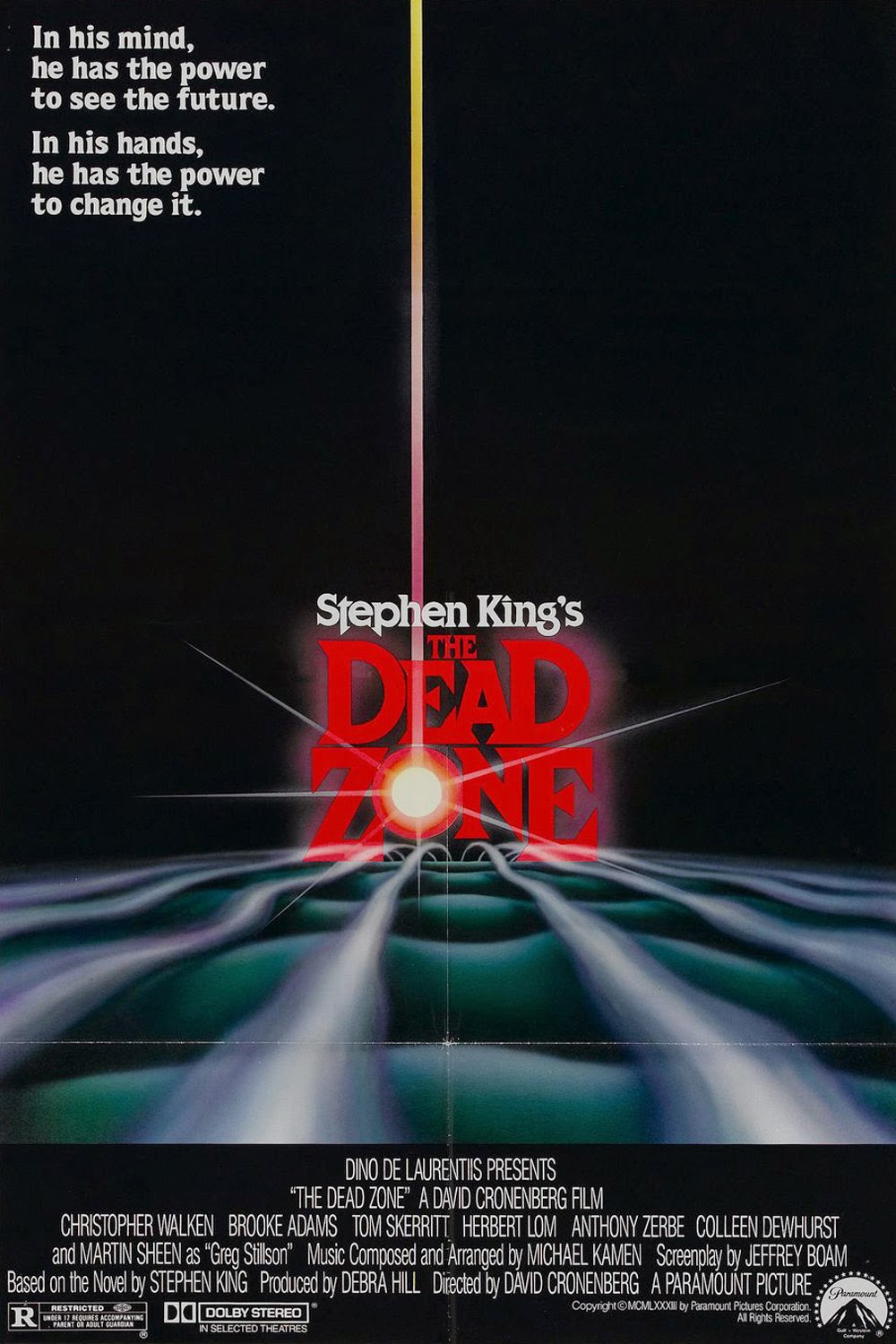The Dead Zone from 1983 is more of a dramatic thriller than an actual horror movie. However, the film does have a looming darkness that director David Cronenberg really brings to light, so to speak. It's not obvious, but subtleties are definitely Cronenberg's forte.
This is a adaptation of a Stephen King short story. What horror movie marathon would be complete without a King picture? The film follows Johnny Smith (Christopher Walken) after he awakens from a five year coma. Smith learns that he can see someone's future if he touches them. Obviously, this is something that he couldn't do before. He is bombarded by news reporters to show an example. This bothers him, as you can really see the frustration. He just wants to be left alone but has the task of town-hero thrust upon him. To make matters worse, his girlfriend from before the accident is now married and living happily with some local political jagoff. He is literally just trying to live his life and stay out of peoples way. But they keep pulling him back in.
I don't really know how this movie was classified as a horror movie. It's not very scary and has almost no horrific attributes. Walken's character does see some pretty gruesome stuff. He witnesses murders, children drowning, and Nuclear war. However, none of it actually happens on camera so it's hard to get a sense of dread. However, maybe it is just the thin veil of darkness and dread that makes this picture scary? Perhaps. Perhaps the horror is delivered to us so subtly by Cronenberg that it makes it up to us. That being said, this is definitely the weakest of Cronenberg's work and the least terrifying of King's books. However, it's not bad. Other actors in the movie do a great job. Martin Sheen does an exceptional job of playing a dirty politician. Who knows maybe this role helped him later when he did the West Wing.
Christopher Walken is this film. From beginning to end he makes it. Stephen King had wanted Bill Murray to portray Johnny Smith but I cannot see it. The film is great as a dramatic terror and maybe that is how it should have been portrayed. As a horror film it just falls flat. The film is actually really pleasing and fun for those that don't want a big dose of horror. If you love Walken's work then this movie is a must see for you.
This is a adaptation of a Stephen King short story. What horror movie marathon would be complete without a King picture? The film follows Johnny Smith (Christopher Walken) after he awakens from a five year coma. Smith learns that he can see someone's future if he touches them. Obviously, this is something that he couldn't do before. He is bombarded by news reporters to show an example. This bothers him, as you can really see the frustration. He just wants to be left alone but has the task of town-hero thrust upon him. To make matters worse, his girlfriend from before the accident is now married and living happily with some local political jagoff. He is literally just trying to live his life and stay out of peoples way. But they keep pulling him back in.
I don't really know how this movie was classified as a horror movie. It's not very scary and has almost no horrific attributes. Walken's character does see some pretty gruesome stuff. He witnesses murders, children drowning, and Nuclear war. However, none of it actually happens on camera so it's hard to get a sense of dread. However, maybe it is just the thin veil of darkness and dread that makes this picture scary? Perhaps. Perhaps the horror is delivered to us so subtly by Cronenberg that it makes it up to us. That being said, this is definitely the weakest of Cronenberg's work and the least terrifying of King's books. However, it's not bad. Other actors in the movie do a great job. Martin Sheen does an exceptional job of playing a dirty politician. Who knows maybe this role helped him later when he did the West Wing.
Christopher Walken is this film. From beginning to end he makes it. Stephen King had wanted Bill Murray to portray Johnny Smith but I cannot see it. The film is great as a dramatic terror and maybe that is how it should have been portrayed. As a horror film it just falls flat. The film is actually really pleasing and fun for those that don't want a big dose of horror. If you love Walken's work then this movie is a must see for you.
- During the time Michael Kamen was composing the music for the film in London, he would play the score on the piano in his home. He received several complaints by his neighbors who asked, "Can you please stop playing that music? I can't sleep and it's giving my family nightmares."
- David Cronenberg wanted to change the name of Christopher Walken's character: "I'd never name someone 'Johnny Smith'", he quipped, but in the end it was left as is. The book does specifically mention how it sounds like a fake name.
- The gazebo where the murder took place was built for the film, and was later donated to the town of Niagara-on-the-Lake, Ontario, where it was filmed and is now a favorite spot for wedding photographs.

Comments